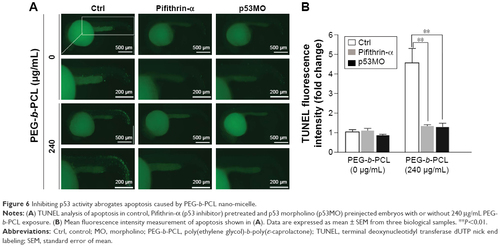- Title
-
PEG-b-PCL polymeric nano-micelle inhibits vascular angiogenesis by activating p53-dependent apoptosis in zebrafish.
- Authors
- Zhou, T., Dong, Q., Shen, Y., Wu, W., Wu, H., Luo, X., Liao, X., Wang, G.
- Source
- Full text @ Int. J. Nanomedicine
|
Figure 2 Embryo chorion absorption of PEG-b-PCL nano-micelles. |
|
Figure 3 Effects of PEG-b-PCL on zebrafish embryos and larva. |
|
Figure 4 PEG-b-PCL nano-micelle inhibits angiogenesis in zebrafish embryo. |
|
Figure 5 PEG-b-PCL nano-micelle induces apoptosis in zebrafish embryos. |
|
Figure 6 Inhibiting p53 activity abrogates apoptosis caused by PEG-b-PCL nano-micelle. |
|
Figure 7 p53 inhibition abrogates the angiogenic defects caused by PEG-b-PCL nano-micelle. |






